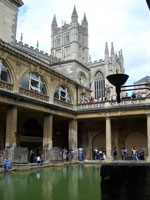 Bath OverviewThe Romans established the City of Bath in the year 43 AD and
this city, awash with fabulous architecture, history and culture,
has been welcoming visitors ever since. Many of Bath's great
buildings date back from its renaissance in the 18th century when
it again became a fashionable spa town and played host to royalty
and the cream of aristocracy, who famously visited the city to
'take the waters'. Today visitors can walk around the old Roman
Baths, enjoy the splendour of Bath Abbey or simply take in the
breathtaking Georgian architecture of this beautiful city, which
somehow managed to escape the ravages of industry and the
Luftwaffe. Jane Austen lived and based several of her books in Bath, and on
Gay Street, near her home, visitors can find the Jane Austen
Centre, which displays her life and times. For an authentic feel of
life gone by, period decorations and furniture have been reinstated
in No1 Royal Crescent, so that the house appears as it did in its
days as a fine 18th-century townhouse. Bath is home to much older attractions than its Elizabethan
charms, featuring the famous ancient Roman baths, situated over
natural hot springs. Bath was a prosperous tourist destination as
early as its Roman occupation, when the baths were built, and
continued its reputation as a therapeutic health resort through the
medieval period. Though architecturally Bath is something of a period piece, it
is also a very modern city. Its restaurants and pavement cafés are
packed full of local businessmen and artisans, and its cinemas,
pubs, and nightclubs keep its residents entertained each evening.
Bath's answer to Camden Market is Walcot Street, where a bohemian
street market takes places each weekend; and its parks and gardens
are popular places to relax and enjoy pleasant weather. The International Music Festival marks the beginning of summer
and adds to Bath's lively, festive atmosphere, and its Theatre
Royal is one of the country's leading provincial theatres,
attracting big names and pre-West End show runs. |